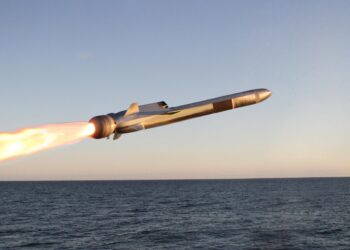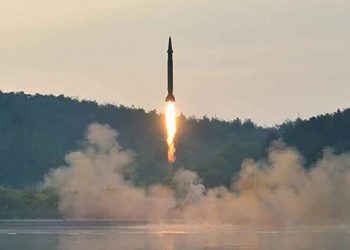US Department of Defense, ALEXANDRIA: Arming submarines with nonnuclear intercontinental ballistic missiles will give America a necessary quick-strike weapon in the war on terror, the vice chairman of the Joint Chiefs of Staff said here yesterday.
The proposal, part of the Defense Department's 2007 budget request, aims to remove two nuclear missiles from each of the Navy's 14 ballistic missile submarines, or SSBNs, and replace them with two conventionally armed Trident missiles, said Navy Adm. Edmund P. Giambastiani at the Naval Submarine League's annual symposium.
The move would put about 22 such missiles into operational deployment, he said.
“It's meant to be a very niche capability,” Giambastiani told about 400 retired officers, businessmen and fellow submariners. “We're not talking a lot of missiles here. So this really is a small, quick-strike capability.
“Why would you want it?,” the vice chairman, whose career spans many submarine assignments and commands, asked. “So that you can respond within 60 minutes or so to something at very long ranges, very precisely, assuming you have very precise knowledge.”
Combatant commanders are looking for ways to increase operational availability throughout the military, Giambastiani said. “That's what an SSBN is, the ultimate operationally available platform,” he said. From that perspective, giving ballistic missile submarines a nonnuclear role makes sense.
Giambastiani said he is not worried about concerns raised about what level of authority should be required to launch the missiles or whether two-way communication was necessary between a submerged submarine and a command authority, because he would use the system that's already in place. He said he sees the value in “using a command and control system that over the years has been proven but requires the highest level of release authority.”
One concern being addressed, however, is how to maneuver a potential launch so the missile's flight path doesn't appear threatening to someone who could see it coming and worry it was coming to hit them, he said. Precautions are being taken, but under almost every conceivable scenario, a small launch would not touch off alarms.
“There are some people who think if we fire one missile you're going to go to nuclear war,” he said. “Well it's just the opposite, and we've found that over a few launches over the years.”
Converting existing platforms to make them more adaptable to today's warfighting environment can be a very cost-effective endeavor, he said. Already the Navy has transformed two of the four oldest SSBNs into guided-missile submarines, called SSGNs, which carry the Tomahawk land-attack cruise missile.
“SSGN, the follow-on to the Trident, is clearly one of those examples of a very successful, quick-turn program,” he said. “It's not too bad if you can introduce it officially in the Department of Defense at the end of September 2001, put it in the budget with the president's submission in February 2002, have it become an effective program on the first of October 2002, and already have two deliveries with two others to be following shortly. That's big stuff.”
Giambastiani challenged the audience of submariners to continue to use that “modular approach” to problem solving, removing one part of a well-working machine and replacing that part with something more relevant to the current mission.
He also said the group should continue to seek different perspectives on how to develop solutions.
“You never want to bring everybody in who looks like you,” he said. “You want people who come at problems from a different perspective, and submarine folks do that exceptionally well. They're mission-oriented, goal-oriented, they're smart, and they're useful.”
Working jointly with other services — combining resources and communicating effectively — is the way business has to be conducted now, Giambastiani said. Since the Cold War ended, the submarine force, like the rest of the nation's armed services has had to learn to be flexible.
“It is a complicated world,” he said. “How can we make the most adaptable, flexible forces to respond to these things across the board? That's what we're spending most of our time doing, trying to be adaptable.”
Britain, Germany jointly developing missiles: ministers
Britain and Germany are working together to develop strike missiles, their defence ministers said Thursday, as Russia's war rages in...









